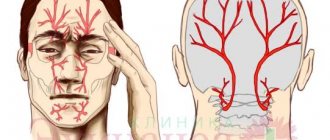What is psychopathy
Psychopathic disorder is a painful variant of human behavior, often a sociopath, expressed in the excessive manifestation of negative character traits.
Most often he stands out:
- Heartlessness, rudeness, rudeness.
- A complete lack of sensitivity to other people's problems and pain.
- Reluctance to consider the opinions of others.
- Antisocial behavior with violent tendencies.
- The feeling of being right in situations where there is clear evidence to the contrary.
In the opposite type of disorder, painfully excessive:
- Anxiety.
- Indecisiveness.
- Closedness.
- Impressionability and self-deprecation.
In psychiatry, this type of behavior is not considered a disease in the literal sense. It is rather a social deviation with painful traits that requires specific correction. At the same time, psychiatrists have to deal with complex cases of this disorder.
Paranoid syndrome. Paranoid syndrome
Paranoid syndrome. Primary systematized delirium of interpretation of various contents (jealousy, invention, persecution, reformism, etc.), occasionally existing as a monosymptom in the complete absence of other productive disorders. If the latter arise, they are located on the periphery of the paranoid structure and are subordinated to it. Characterized by a paralogical structure of thinking (“crooked thinking”) and delusional detailing.
The ability to make correct judgments and conclusions on issues that do not affect delusional beliefs is not noticeably impaired, which indicates catathymic (that is, associated with an unconscious complex of affectively colored ideas, and not a general change in mood) mechanisms of delusion formation. Memory disturbances in the form of delusional confabulations (“memory hallucinations”) may occur. In addition, there are hallucinations of the imagination, the content of which is associated with dominant experiences. As delirium expands, an ever wider range of phenomena becomes the object of pathological interpretations. There is also a delusional interpretation of past events. Paranoid syndrome usually occurs against the background of somewhat elevated mood (expansive delusions) or subdepression (sensitive, hypochondriacal delusions).
| | We will help you cope with paranoid syndrome! |
The content of delusions at distant stages of development can acquire a metallomaniac character. Unlike paraphrenia, delusion continues to be interpretive and in its scope does not go beyond the scope of what is fundamentally possible in reality (“prophets, outstanding discoverers, brilliant scientists and writers, great reformers”, etc.). There are chronic, existing for a number or even decades, and acute versions of paranoid syndrome. Chronic paranoid delusions are most often observed in relatively slowly developing delusional schizophrenia. Delirium in such cases is usually monothematic. The possibility cannot be ruled out that there is an independent form of the disease - paranoia.
Acute, usually less systematized paranoid states are more common in the structure of attacks of fur-like schizophrenia. The delusional concept is loose, unstable and can have several different themes or centers of crystallization of false judgments.
Some authors consider it justified to distinguish between paranoid and paranoid syndromes (Zavilyansky et al., 1989). Chronic, systematized, overvalued delusions (beginning with overvalued ideas) that arise under the influence of a key psychotraumatic situation for the patient are called paranoid. Paranoid and epileptoid features of the premorbid personality of constitutional, post-processual or organic origin contribute to the development of delusions. The mechanisms of delusion formation are associated with psychological rather than biological disorders - “psychogenic-reactive” delusion formation. Paranoid syndrome in this interpretation is appropriate to consider within the framework of pathological personality development.
Paranoid or hallucinatory-paranoid syndrome. Includes delusional ideas of persecutory content, hallucinations, pseudohallucinations and other phenomena of mental automatism, affective disorders. There are acute and chronic hallucinatory-paranoid syndromes.
| | Paranoid syndrome accompanies paranoid schizophrenia |
Acute paranoid is an acute sensory delusion of persecution (in the form of delusions of perception) of a specific orientation, accompanied by verbal illusions, hallucinations, fear, anxiety, confusion, and abnormal behavior reflecting the content of delusional ideas. It is observed in schizophrenia, intoxication, and epileptic psychoses. Acute paranoid states can also occur in special situations (long journeys associated with insomnia, alcohol intoxication, emotional stress, somatogenies) - road or situational paranoids, described by S.G. Zhislin.
Acute hallucinatory-paranoid syndrome is an acute sensory delusion of persecutory content, arising against a background of fear, confusion and combined with pseudohallucinations and other phenomena of mental automatism. It is more common in the structure of attacks of fur-like schizophrenia, with atypical alcoholic psychoses. Chronic hallucinatory-paranoid syndrome (synonyms: Kandinsky-Clerambault syndrome, other eponyms, mental automatism syndrome, invasion syndrome, deposition syndrome, xenopathic syndrome, parasitism syndrome, influence syndrome, external influence syndrome, alienation syndrome, mastery syndrome, polyphrenia, nuclear syndrome) — the difference in names reflects the difference in the opinions of their authors regarding which disorders should be considered determining the structure of the syndrome: mental automatisms, disorders of self-awareness, the experience of openness or delusional ideas of physical and mental influence.
Mental automatisms in their completed form represent the experience of violence, invasion, the doneness of one’s own mental processes, behavior, and physiological acts. The following types of mental automatisms are distinguished.
Associative or ideational automatism - disorders of mental activity, memory, perception, affective sphere, occurring with the experience of alienation and violence: influxes of thoughts, non-stop flow of thoughts, states of blockade of mental activity, symptoms of investing, reading thoughts, symptom of unwinding memories, pseudohallucinatory pseudomemories, sudden delays memories, the phenomenon of figurative mentalism, etc.
Manifestations of ideational automatism also include auditory and visual pseudohallucinations, as well as a number of affective disorders: “induced” mood, “induced” fear, anger, ecstasy, “induced” sadness or indifference, etc. This group of automatisms includes “ made” dreams. The inclusion of auditory verbal and visual pseudohallucinations in the group of ideational automatisms is due to their close connection with thinking processes: verbal pseudohallucinations with verbal ones, and visual ones with figurative forms of thinking.
Senestopathic or sensory automatism is a variety of senestopathic sensations, the appearance of which patients associate with the influence of external forces. In addition, this includes olfactory, gustatory, tactile and endosomatic pseudohallucinations. Sensory automatism includes various changes in appetite, taste, smell, sexual desire and physiological needs, as well as sleep disturbances, autonomic disorders (tachycardia, excessive sweating, vomiting, diarrhea, etc.), “caused,” according to patients, from the outside.
Kinesthetic or motor automatism - impulses to activity, individual movements, actions, deeds, expressive acts, hyperkinesis that arise with the experience of violence. Receptive processes can also occur with the phenomena of being made: “They force you to look, listen, smell, look with my eyes...”, etc.
Speech motor automatism - phenomena of forced speaking, writing, as well as kinesthetic verbal and graphic hallucinations.
The formation of mental automatisms occurs in a certain sequence. At the first stage of development of ideatorial automatism, “strange, unexpected, wild, parallel, intersecting” thoughts appear, alien in content to the entire structure of the personality: “I never think like that...” At the same time, sudden interruptions of necessary thoughts may occur. Alienation concerns the content of thoughts, but not the process of thinking itself (“my thoughts, but very strange ones”).
Then the feeling of one’s own thinking activity is lost: “Thoughts float, go on their own, flow non-stop...” or states of blockade of mental activity arise. Subsequently, the alienation becomes total - the sense of belonging to one’s own thoughts is completely lost: “Thoughts are not mine, someone is thinking in me, other people’s thoughts are in my head...” Finally, a feeling arises as if thoughts “come from the outside, are introduced into the head, are invested... “Telepathic contacts with other people arise, the ability to directly read the thoughts of others and mentally communicate with others appears. At the same time, patients may claim that at times they are deprived of the ability to think or that they are “pulled out of thoughts” or “stolen.”
The development of verbal pseudohallucinations can occur as follows. First, the phenomenon of the sound of one’s own thoughts arises: “Thoughts rustle and sound in the head.” Then your own voice begins to be heard in your head, “voicing”, and sometimes like an “echo”, repeating your thoughts. This can be called inner speech hallucinations. The content of statements gradually expands (statements, comments, advice, orders, etc.), while the voice “doubles, multiplies.”
Then “other people’s voices” are heard in my head. The content of their statements is becoming more and more diverse, divorced from the reality and personality of the patients. In other words, the alienation of the process of internal speaking also increases in a certain sequence. Finally, the phenomenon of “made, induced voices” arises. The voices speak on a variety of topics, often abstracted from personal experiences, sometimes reporting absurd and fantastic information: “The voices behind the ears speak about local topics, but in the head they speak about national ones.” The degree of alienation of what is said by voices can therefore be different.
The dynamics of kinesthetic automatism generally correspond to those described above. At first, previously unusual impulses to action and impulsive desires appear, and strange and unexpected actions and actions are performed for the patients themselves. Subjectively, they are perceived as belonging to one’s own personality, although unusual in content. There may be short stops of action. Subsequently, actions and deeds are performed without a sense of one’s own activity, involuntarily: “I do it without noticing it, and when I notice it, it’s hard to stop.” Conditions of blockade or “paralysis” of impulses to action arise.
At the next stage, activity proceeds with a clear experience of alienation of one’s own activity and violence: “Something is pushing from within, prompting, not a voice, but some kind of internal force...” Episodes of interruption of action are also experienced with a tinge of violence. At the final stage of development of motor automatisms, a feeling appears that motor acts are done from the outside: “My body is controlled... Someone controls my hands... One hand belongs to my wife, the other belongs to my stepfather, my legs belong to me... They look with my eyes...” The states of blockade occur with a feeling of external influence. incentives to action.
The sequence of development of speech motor automatisms may be similar. At first, individual words or phrases are broken out, alien to the direction of the patient’s thoughts, absurd in content. Often individual words are suddenly forgotten or the formulation of thoughts is disrupted. Then the feeling of one’s own activity that accompanies speech is lost: “The tongue speaks on its own, I’ll say it, and then the meaning of what was said comes through... Sometimes I start talking...” Or the tongue stops for a short time and does not listen. Next, a feeling of alienation and violence arises in relation to one’s own speech:
“It’s as if it’s not me who speaks, but something in me... My double is using the language, and I’m not able to stop the speech...” Episodes of mutism are experienced as violent. Finally, a feeling of external mastery of speech arises: “Strangers speak my language... They give lectures on international topics in my language, and at this time I don’t think about anything at all...” Conditions of loss of spontaneous speech are also associated with external phenomena. The development of speech motor automatisms can begin with the appearance of kinesthetic verbal hallucinations: there is a feeling of movement of the articulatory apparatus corresponding to speech, and the idea of involuntary mental pronunciation of words. Subsequently, the internal monologue acquires a verbal-acoustic connotation, and a slight movement of the tongue and lips appears. At the final stage, true articulatory movements arise with the actual pronunciation of words out loud.
Senestopathic automatism usually develops immediately, bypassing certain intermediate stages. Only in some cases, before its appearance, can one state the phenomenon of alienation of senestopathic sensations: “Terrible headaches, and at the same time it seems that this is not happening to me, but to someone else...”
In the structure of mental automatisms, Clerambault distinguished two types of polar phenomena: positive and negative. The content of the former is the pathological activity of any functional system, the latter is the suspension or blockade of the activity of the corresponding system. Positive automatisms in the field of ideation disorders are a violent flow of thoughts, a symptom of investing thoughts, a symptom of unwinding memories, made emotions, induced dreams, verbal and visual pseudohallucinations, etc.
Their antipode, that is, negative automatisms, can be states of blockage of mental activity, a symptom of withdrawal, pulling out thoughts, sudden loss of memory, emotional reactions, negative auditory and visual hallucinations that arise with a feeling of accomplishment, forced deprivation of dreams, etc. In the field of senestopathic Automatism will be, respectively, sensations made and an externally caused loss of sensitivity; in kinesthetic automatism - violent actions and states of delayed motor reactions, taking away the ability to make decisions, blocking impulses for activity. In speech motor automatism, the polar phenomena will be forced speaking and sudden speech delays.
According to Clerambault, schizophrenia is more characterized by negative phenomena, especially if the disease begins at a young age. In fact, positive and negative automatisms can be combined. Thus, forced speaking is usually accompanied by a state of blockade of mental activity: “The tongue speaks, but at this time I am not thinking about anything, there are no thoughts.”
Disorders of self-awareness that arise in the syndrome of mental automatism are expressed by the phenomena of alienation of one’s own mental processes, the experience of the violence of their course, dual personality and the consciousness of an internal antagonistic double, and subsequently - a feeling of mastery by external forces. Despite the seemingly obvious nature of the disorder, patients usually lack a critical attitude towards the disease, which, in turn, may also indicate a gross pathology of self-awareness. Simultaneously with the increase in the phenomena of alienation, the devastation of the sphere of the personal Self progresses.
Some patients even “forget” what it is, their own Self; the old Self-concept no longer exists. There are no mental acts emanating from the name of one’s Self at all; this is a total alienation that has spread to all aspects of the inner Self. At the same time, thanks to appropriation, a person can “acquire” new abilities and characteristics that were not previously inherent in him. Sometimes the phenomenon of transitivism is observed - not only the patient, but also others (or mostly others) are the object of external influence and various kinds of violent manipulation, their own feelings are projected onto others. Unlike the projection itself, the patient is not subjectively freed from painful experiences.
The experience of openness occurs with the appearance of various echo symptoms. A symptom of echo thoughts - those around him, according to the patient, repeat out loud what he was just thinking about. Hallucinatory echo - voices from outside repeat, “duplicate” the patient’s thoughts. A symptom of the sound of one’s own thoughts is that thoughts are immediately repeated, they clearly “rustle, sound in the head, and are heard by others.” Anticipatory echo - voices warn the patient what he will hear, see, feel or do after some time. Echo of actions - voices state the actions, intentions of the patient: “I am being photographed, my actions are being recorded...” It happens that the voices are read for the patient, but he only sees the text.
Voices can repeat and comment on motives and behavior, give them one or another assessment, which is also accompanied by the experience of openness: “Everyone knows about me, nothing remains to myself.” Echo of writing - voices repeat what the patient is writing. Echo of speech - voices repeat everything the patient said out loud to someone. Sometimes the voices force or ask the patient to repeat for them what he told others, or, on the contrary, to mentally or out loud say again what he heard from someone, and the patient, like an echo, repeats this. The “hallucinatory personality” here seems to be deprived of contact with the outside world, establishing it with the help of the patient.
There is no name for this symptom, but we will conditionally call it the echo-patient phenomenon. The above echo phenomena can be iterative in the form of multiple repetitions. Thus, a patient (he is 11 years old) has episodes that last two to three hours, when what was said by other people three to five times in someone else’s voice is repeated in his head. One word is repeated more often. During repetitions, he perceives what is happening worse and cannot watch TV. Other echophenomena occur. Thus, the speech of others can be repeated by voices from outside or in the head - a symptom of echo-alien speech.
Voices with external projection are sometimes duplicated by internal ones - a symptom of echovoices. The experience of openness can also be observed in the absence of echo symptoms, arising in the most direct way: “I feel that my thoughts are known to everyone... There is a feeling that God knows everything about me - I am in front of him like an open book... The voices are silent, which means they are eavesdropping on what I think "
Delusion of physical and mental influence - a belief in the influence on the body, somatic and mental processes of various external forces: hypnosis, witchcraft, rays, biofields, etc.
In addition to the above-described phenomena of alienation, in the syndrome of mental automatism, opposite phenomena may occur - the phenomena of appropriation, which constitute an active or inverted version of the Kandinsky-Clerambault syndrome. In this case, patients express the belief that they themselves have a hypnotic effect on others, control their behavior, are able to read the thoughts of other people, the latter have turned into an instrument of their power, behave like dolls, puppets, parsleys, etc. Combination of alienation phenomena and assignments V.I. Akkerman (1936) considered a sign characteristic of schizophrenia.
There are hallucinatory and delusional variants of mental automatism syndrome.
In the first of them, various pseudohallucinations predominate, which is observed mainly during acute hallucinatory-delusional states in schizophrenia, in the second - delusional phenomena that dominate in chronically ongoing paranoid schizophrenia. In chronic schizophrenic delusions of the interpretative type, associative automatisms come to the fore over time. Senestopathic automatisms may predominate in the structure of attacks of fur-like schizophrenia. In lucid-catatonic states, kinesthetic automatisms occupy a significant place. In addition to schizophrenia, phenomena of mental automatism can occur in exogenous-organic, acute and chronic epileptic psychoses. Back to contents
COST OF TREATMENT FOR MENTAL DISEASES
The duration of treatment in a hospital is from 14 to 90 days, depending on the severity of the disease.
TREATMENT IN A HOSPITAL.
AMBULATORY TREATMENT
TREATMENT IN A HOSPITAL
Inpatient treatment – accommodation options
| Accommodation in a triple room | 10,000 rub./day |
| Double room | RUB 13,800/day |
| Single room of increased comfort | 16,000 rub./day |
| Treatment in a single VIP ward | 25,000 rub./day |
AMBULATORY TREATMENT
Ambulatory treatment
| psychiatrist | FOR FREE |
| Consultation with a psychiatrist (first appointment) – free of charge during hospitalization | 3,000 rub. |
| Full psychodiagnostics (all tests and procedures) | from 5,000 rub. |
| Appointment with the head physician of the clinic | 4,500 rub. |
| Consultation with a psychiatrist at home | from 4,000 rub. |
FREE CONSULTATION
Causes of psychopathy
The factors leading to the development of personality deviations are very diverse.
Important psychiatrists include:
- Heredity. The manifestation of psychopathic problems in the family is a prerequisite for their occurrence in close relatives.
- Pathology of pregnancy, complicated childbirth and painful childhood.
- Unfavorable environment of upbringing and life with the experience of psychophysical violence, tyranny, inappropriate behavior of persons (in places of deprivation of liberty), on whom the psychopath was dependent.
- Transference of psychologically traumatic situations: deaths, disasters, accidents, wars and other factors that have a destructive impact on the psyche.
Types of psychopathy, signs and symptoms, stages
Precursors of a psychopathic state - personality accentuations - occur on average in 10% of the population. It is these individuals who most often become psycho-sociopaths. The percentage of patients suffering from this disorder among all people is quite high. According to statistics, it is within 1-2%. Individuals with aggressive types of the disorder pose a danger to society.
The main signs of this type of psychopathy:
- Extreme degree of egocentrism.
- Cruelty reaching the point of sadism.
- Unceremoniousness and unwillingness to take into account someone's opinion.
- Despotism, a painful desire for power and control of other people.
- A sharp decrease or absence of emotional experiences.
It is this psychotype that is most often associated with crime. Men are more prone to physical forms of expression of psychopathic deviations, while among women psychological ones dominate. The psycho-social treatment of such persons is a particularly responsible matter.
Characters. How to learn and tame
External signs
The external manifestations of a paranoid person are dominated by business concerns. People around him get the impression that this person always has serious intentions. A paranoid character makes its owner harsh, because he is constantly preoccupied with some important matter and is always directed somewhere.
In essence, paranoia is an active, persistent aspiration. And where there is sharpness and persistence, there is almost always conflict and aggressiveness. Therefore, many specialists in the field of characterology in their works call the paranoid the most aggressive type of character (M. E. Burno, P. B. Gannushkin, A. P. Egides, P. V. Volkov, etc.). Another name for this character, which is found in professional psychiatric literature, is unbalanced. Indeed, despite all the persistence of aspirations and goals, such people exhibit spontaneity, which is expressed in instability of behavior.
Much depends on what other component is present in the structure of a person’s personality. If this is a hysterical component, then he (or she) will stage manipulative pranks, strive to receive as much attention as possible from others, decorate his life and himself with various decorative elements, try to get into the upper echelons of society and have a tendency to lie.
If, for example, there is an additional schizoid component, then such a paranoid person will most likely become more secretive in communication, will be inclined to form his own theories and will not get along well with the people around him because of his conflict and love of solitude.
How to recognize a paranoid person in a crowd? It will probably be difficult to do this right away. The paranoid type, like all other types of human characters, does not have a sign that says: “I am paranoid.” Therefore, it is necessary to study, look closely at people, observe and notice their characteristics in speech, behavior and appearance.
A person with a paranoid character is almost always puzzled by some problem. He sets a goal that is clear and important, and sometimes it may even seem that everyone needs it, and not just him alone. After setting a goal, he looks for means to achieve it. For this, a paranoid person is ready to do literally anything.
For a paranoid person, sacrificing not only one’s own interests, but also the interests of others to achieve a noble goal are the same and normal things. If he decides to buy himself, say, a car (you must admit, this is a useful thing in any household and there is no need to prove the need for this purchase), and his earnings are not enough for this, then the paranoid person will begin to look for funds to buy it. He will save money, not only his own, but also that of other family members. He will force household members to work and give him their money and savings. So it turns out that to achieve the goal set by one person, everyone else is involved.
Another example. If a person with a paranoid character decides that injustice is being done to his people, then he will immediately want to correct it and for this he will become involved in politics, and his entire family will turn into persons contributing to this process. Mother and grandmother will stand at rallies, children will hand out leaflets, the rest will agitate as best they can. There is a use for everything.
A person with a paranoid character believes that these achievements are for the sake of the common good, and therefore he has the right to decide who and what to do, who and what to sacrifice. The paranoid himself blindly believes in his exclusivity, his special purpose, and it is easy for him to convince people of this. He is a reformer, he always breaks down the old in order to build a new, better one for everyone.
Hiding behind just such good goals, many well-known politicians with a paranoid character came to power, such as Peter I, Richelieu, V. Lenin, L. Trotsky, Mao Zedong, A. Hitler, R. Nixon, Kim Il Sung, A. Lukashenko. The paranoid personality type can also include deputy V. Novodvorskaya, writer A. Solzhenitsyn and others. All of them are leaders, fighters and revolutionaries, bright personalities with such a character, but at the same time they made a great contribution to the development of not only their country.
If you trace the line of their biographies, it will become clear that all these individuals are united by a great desire for a goal (each has their own). All of them were active reformers from a young age, but behind their reforms are thousands of lives of people who were not asked whether they wanted to be cogs in the machine of progress.
Fortunately for other people, there are few such major figures born in the world. However, it is precisely the paranoid personality trait that makes a person impetuous and assertive in accomplishing his “just cause.”
It happens that in the appearance of people with a paranoid character there are some physical defects or some features, due to which they may experience a feeling of inferiority in childhood and later life. Because of these differences, they often face insults from other children or bullying from others.
For example, a big nose, or poor eyesight, or a poor family, or alcoholic parents, or a nationality that is not the same as everyone else. Awareness of one's inferiority and the negative attitude of the social environment contribute to the development of paranoid character traits. The child may understand that he does not deserve such an attitude and decides to correct this in his life. This idea literally occupies his consciousness until he realizes it.
Diagnostics
The examination stage requires some time from the doctors of our clinic.
To make an accurate diagnosis, they use:
- A conversation in the form of a dialogue, during which all the nuances of the person being examined are gradually clarified.
- Conversation with relatives.
- Dynamic monitoring of the patient.
A psychologist is involved in the diagnostic process, supplementing medical data with test methods and a special PSL-R questionnaire. He also makes additional recommendations for treatment.
When diagnosing, it is important not only to establish the psychopathic type, but also the stage of the process:
- Compensated.
- Subcompensated.
- Decompensated.
These data must be taken into account when prescribing treatment.
Types of psychopathy
Modern views on the problem have led to the formation of multiple classifications. Let's consider the most applicable one in domestic practice. It is based on the theoretical views and practical developments of Russian scientists, followers of P.B Gannushkin.
In the clinic of psychopathy, the following forms are distinguished:
- Asthenic – with characteristic fearfulness, psychophysical weakness, vegetative disorders. Mimosa type.
- Psychasthenic – manifested by excessive indecision, introspection, anxiety and fear of responsibility.
- Schizoid. The bearer of this psychopathic portrait is closed, self-absorbed, prone to intellectual activities, striving to direct all his talents to self-satisfaction. Knowing his worth, absolutely indifferent to others, capable of self-destruction and unemotional harm to other people.
- Paranoid. The patient is a stuck, stubborn and touchy bearer of overvalued ideas, often of a destructive nature, who pursues their implementation to the end.
- Epileptoid. Has excitability, rage and anger of extreme strength. Doesn't forgive anyone's mistakes and is vengeful. The idea of vengeance can be carried around for decades unnoticed by others.
- Hysterical. Actor type. Obsessed with himself and demands the attention of others. He often lies to please himself and to get what he wants. Prone to taking psychoactive substances.
- Cycloid. A client with a sharply changing emotional background. From depression with depression he falls into the status of hyperthymic. In both cases there is a tendency towards socially pathological behavior.
Clinical variants of psychopathy. Paranoid psychopathy
This text is based on P.B. Gannushkin’s approach to describing psychopathy. P.B. Gannushkin, as you know, preferred to distinguish between groups of psychopathy. The specific variants of psychopathy that form these groups, along with common characteristics, also have some specific clinical features.
Group of paranoid (paranoid) psychopathy. Common signs of paranoids are excessive egocentrism, excessive self-love and unencumbered by special virtues, a hostile attitude towards people, a tendency to active or passive aggressive actions, a lack of altruistic motives and impoverishment of higher feelings. The need for personal safety and the desire to strictly control what is happening around prevail. This probably hides a deep-seated lack of confidence in oneself and one’s ability to repel threats to one’s self.
| | Is the psychopathy of a loved one preventing you from living life to the fullest? Contact our psychiatric clinic. We will help! |
The level of motivation is reduced; in any case, high ideals and values are alien to patients, which results in the absence of an intense struggle of motives, as well as the ease with which decisions are made. Internal motivation predominates: punishments, rewards, real achievements mean little. Satisfaction comes only from the illusion of one's own safety. Disconnection from reality and the pursuit of the specter of safety prevent patients from changing their behavior, even if they want to. Meanwhile, by their behavior, patients only increase the threat to personal well-being. Typically, patients are unable to achieve significant success in the main areas of life, if we understand the latter as love, friendship, work, family and creativity. Let us describe the following variants of this group of psychopathy.
Expansive paranoids are “ideological fighters” or “fighters for justice”; such patients consider the most important or most significant what they do or have done themselves: any, even routine activity, an innovation they proposed, something written by them, this or that a look at what happened or is happening, some idea of reconstruction, etc. For example, an artist “creates” by gluing pieces of various minerals to pieces of rusty iron, and at the same time considers his crafts to be masterpieces of art, which other people simply must know about, if want to consider themselves cultural members of society.
The main belief of patients is that they are exceptional, outstanding individuals; they often consider themselves “unrecognized geniuses,” which others are unable to understand or do not want to accept. Patients sincerely believe that they are surrounded by “gray”, “ordinary” natures, “mediocre people”, “a faceless crowd”, that they are “envied”, “not allowed to move”, “silenced”, and want to take advantage of the fruits of their invaluable activity. The resistance of others embitters and embitters the patients; indignant, they take the path of an uncompromising struggle for a just cause, that is, for their calling and “worthy” place in society. Possessing inexhaustible energy, the gift of persuasion and capitalizing on the feelings of humiliated people, patients are able to rally many admirers around themselves and, in the eyes of the latter, become almost charismatic personalities who fight for the interests of the “people.” If patients do not meet adequate resistance, they also celebrate victories.
If they suffer defeat, this only adds strength and determination to them to continue the fight, not disdaining any means. Other paranoids, smaller ones, choose the courts as their battlefield, trying to satisfy their claims through persistent litigation or filing countless complaints to various authorities, turning into litigators (persons initiating one lawsuit after another) or querulants (constantly complaining). Perhaps only psychiatrists can block the path of militant paranoids. As long as the paranoid has not embarked on the warpath, he, with his characteristic tenacity, systematicity, accuracy and pedantry, can successfully work in any chosen narrow field.
Illustration. K., 45 years old, film director, “decided to leave the capital and work in the provinces,” where he “could completely devote himself to creativity.” In the very first days of his stay in the new place, he said that the local film studio was “producing hack work,” the specialists were “not capable of anything,” and the management was “no good,” and he, having far-reaching creative plans, “will put things in order here.”
After his creative projects were questioned and he was denied an apartment out of turn, he felt insulted: “they humiliated me,” “they decided to mix me with dirt.” “As a person who respects and knows his worth, I could not leave this without consequences.” The anger fell primarily on the studio management. “I told them they only had one choice: me or them.” The patient began to sharply criticize work plans at planning meetings, allowing himself sharp caustic remarks, creating an extremely nervous environment with altercations and attacks against himself. He carefully recorded the speeches of his opponents, and then began to write numerous complaints to various authorities. The team quarreled, talking about who spoke about someone and how. He organized a support group of people who were dissatisfied with the management, speaking on behalf of the “workers”. Endless inspections rained down on the studio, people began to quit and end up in hospitals.
As a result, the work of the studio actually stopped, turning into a showdown. Finally, two years later, he turned to psychiatrists for help. To prove that he was healthy, the patient voluntarily agreed to be examined. In conversations with the doctor and at the consultation, he behaved arrogantly, believing that he was absolutely right in what happened. He showed brilliant abilities for demagoguery. He often got into arguments, answered with questions, and demanded written evidence that he was unwell. He said that “your entire psychiatry is built on sand,” “I will go to another city, and they will write what I need, and then in court we will find out which of us is right.” He threatened to deprive doctors of their diplomas. He was in an elevated, “fighting” mood, verbose, categorical in his judgments, indignant at the injustice, accusing everyone of mutual responsibility: “This is a conspiracy, the fool knows.” “I will not leave this without consequences, you will remember me for a long time.” Proud to have “disturbed yet another pile of crap.” It turned out that the patient had previously changed about 10 jobs where something similar to what was described here happened.
Sensitive paranoids are narcissistic egoists, constantly focused on a feeling of inferiority, usually greatly exaggerated. They display sensitive ideas about relationships, avoid communication, are often lonely, have difficulty working in a team, and are prone to changing places of work and residence in search of a refuge where they feel more or less comfortable. In communication they prefer people with various disabilities; in such an environment they can behave patronizingly and even arrogantly. Other people's misfortunes are met with gloating. They are envious of prosperous people, petty and secretly vindictive, unkind, as if blaming them for their troubles.
They experience their own misfortunes hard, consider their fate unfair, become embittered, or may decide to commit suicide. If they suffer from infectious diseases, they can deliberately spread the infection around themselves in order to infect other people. They are prone to fantasies, imagining themselves as confident, successful and famous people. They are unable to give up the feeling of their inferiority and find themselves in a business in which they could realize their abilities.
Aggressive paranoids are paranoid of inferiority. These are narcissists who believe that others reject them, despising them for some shortcomings. The response for such imaginary hostility is hatred of others, the need for revenge, the desire to cause them pain and suffering in order to feel one’s power over them. Such patients willingly watch films and read texts with cruel and bloody scenes, indulge in fantasies of violent and sadistic content, feeling like some kind of supermen and receiving vicarious pleasure. Virtual and imaginary aggressive experiences are gradually appropriated and internalized. Sooner or later, a change of identity occurs: the painful awareness of one’s inferiority is transformed into a struggle for one’s superiority, for power over people, asserted through violence. The thirst for power is especially easily satisfied by acts of aggression aimed at weak and defenseless people, children, women, the sick and the elderly.
Since in the minds of many people there is a belief that the sexual act is a symbol of the triumph of strength and power, aggressive paranoids often become rapists, and sometimes serial ones. The feeling of omnipotence and power is often achieved through torture or murder without sexual abuse. Thus, according to media reports, two brothers committed the murder of more than 150 women, but they did not rob or rape them. The 20-year-old criminal only killed older people, mostly women; he talked about feeling an unaccountable urge to kill. A former firefighter, expelled from the force, became a serial killer, shooting strangers with a sawn-off shotgun at the first opportunity.
He killed 40 people, but he planned to increase their number to 400. Such criminals know neither remorse nor fear of retribution; some openly regret that they were stopped too early. It is typical that they remember all the crimes in detail and accurately indicate the burial places of the victims, without revealing memory gaps, but can say little about the motives of behavior: they “wanted it”, they were “drawn”, they “couldn’t live without it” ", etc. The intoxication of power, apparently, affected them more powerfully than any drug.
Fanatics are those obsessed with an idea. These are patients who accepted a certain idea from someone, believed in its greatness and began to consider it the most active part of their Self. From that moment on, the fanatic with his inherent passion serves this idea, the meaning of his life converges on it, everything else leaves him indifferent . For the sake of realizing an idea, a fanatic will not spare anything, will not spare anyone, he is ready to lay down his life for it at any moment and without any fear. It is impossible to oppose anything to the indestructible and single-pointed will of a fanatic. Neither persuasion, nor dissuasion, nor the danger of losing what is most precious, nor the prospect of execution - nothing will stop a fanatic. Like aggressive paranoids, only a psychosurgical operation can help here.
Psychiatrists more often have to deal with fanatical believers, especially with adherents of destructive sects, and from time to time - with mass suicides or aggression and terrorist attacks. Fanatics are usually convinced that they are destined to fulfill a high mission, to do something heroic that ordinary people are not able to do. Blinded by the idea, fanatics completely break away from normal life and break all ties with it. Fanatics, it seems, rarely die of natural causes. Their I dies much earlier, since a radical change of ego identity occurs. A significant portion of fanatics are apparently mentally ill individuals.
Paranoid psychopaths. They are distinguished by a persistent feeling of hostility from others, attributing to the latter malicious intent, desires to cause any harm to the patient, damage health, or even take life. Patients are always wary, suspicious, ready to see some kind of catch in everything, to discern ominous hints in the statements of others. They doubt the loyalty of even close people or friends, if they have any. As a rule, they harbor grievances, accumulate hostile feelings, and do not forgive expressions of antipathy, much less openly expressed threats, even those said in a temper. Usually they make different plans for revenge and thereby gradually prepare themselves for an attack.
Often, sometimes unexpectedly, they react with outbursts of anger and acts of aggression. For the most part, patients are closed and avoid frankness, believing that they can pay dearly for it. Life in a family with them can be completely unbearable due to constant nagging, demands for unquestioning obedience, jealousy, cruel punishments for the slightest deviations from the norms they established and the barracks order. Feelings of warmth, care, tenderness, respect for anyone are alien to patients; jokes with them are not safe. Some patients suppress manifestations of their hostility and do not enter into open conflicts; instead, they try to change jobs, place of residence, or settle somewhere far away from people.
Illustration (Carson et al.). X., 40 years old, builder. He believes that his co-workers do not like him, and is afraid that one of them will set him up for a work-related injury, for example, falling from scaffolding. Such concerns arose after a recent argument in a lunch line, when a patient felt his colleague was pushing ahead of the queue and confronted him. After this, the patient began to notice that his new enemy was laughing in the company of other men, and wondered if he was the object of ridicule. He wanted to get into an argument with them, but after thinking about it, he decided that the story could be a figment of his imagination. There was also a fear that if we took action, we could end up in even greater trouble.
The patient rarely speaks on his own initiative, sits tensely in the chair, his eyes are wide open and he carefully monitors all movements in the office. He tries to understand the hidden meaning of the questions that are asked to him, thinks that he is being blamed, and imagines that the doctor is at one with his colleagues. The patient makes it clear that if he did not need sleeping pills, he would not have sought help at all.
As a boy, he was unsociable, believing that other children were uniting against him in order to arrange some kind of meanness for him. He did poorly at school, but blamed his teachers for this: he said that they preferred girls or boys who were “women.” He dropped out of school and became a hardworking worker, but believes that he will never reach a high position. The patient believes that he is being discredited because of his Catholic religion, but he can do little to prove this. He doesn't get along well with bosses or workmates, doesn't understand jokes, and feels best in a situation where he works and eats alone. He changed jobs many times because he felt he was being treated inappropriately.
The patient is cold with his family and demanding of them. His children address him by adding the word "sir" and know that in his presence they should be visible, but not make noise. At home he never manages to sit quietly. He is constantly busy with some routine tasks. He doesn't like guests and gets worried when his wife goes to visit.
Passive-aggressive type of psychopathy. A controversial variant of psychopathy, which is closer to the mild version of paranoid personality disorder. Such patients are envious, overly critical and usually unfriendly towards those in more prominent positions. They believe that they do their job better than others, and reject advice on how to improve it, seeing this as an attempt to find fault or offend them. On occasion they try to let others down by not doing their part of the work, thereby jeopardizing the success of the common cause.
They believe that they are being asked to do more than is necessary and protest against such injustice. They get angry when they are asked to do something they don't want to do, and act deliberately slowly and carelessly, deliberately resorting to such petty revenge. They put off necessary tasks for a long time, as if thereby wanting to cause harm to others, or avoid performing duties, citing forgetfulness or being too busy. They usually do not show active aggression, but they can act with the hands of others without interfering with their atrocity.
Illustration (Carson et al.). The 34-year-old psychiatrist was 15 minutes late for the first interview. He was recently fired from a mental health center because, according to his boss, he was often late for work, missed appointments, forgot appointments, filed reports late, refused to follow instructions, and seemed disinterested in his work. He was surprised and outraged. The patient believed that, given the intolerable conditions in which he had to work, he was doing an excellent job, and considered his boss to be too annoying and demanding. Nevertheless, he admitted that for a long time his relationship with his superiors did not work out.
The patient is in an unhappy marriage. He complains about his wife, calling her a “nitpicker,” saying that she doesn’t understand him. The wife, in turn, complains about his lack of commitment and stubbornness. He refuses any household chores and often does not complete the few things for which he considers himself responsible. Income declarations are submitted late and bills are not paid. The patient is sociable and very charming. However, his friends are usually annoyed by his reluctance to consider company. If, for example, he doesn’t feel like going to a restaurant, then he sulks all evening or “forgets” his wallet.
Back to contents











